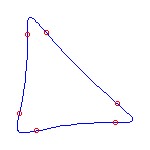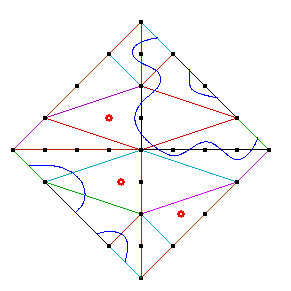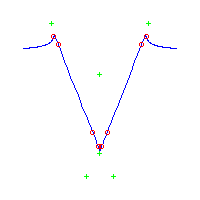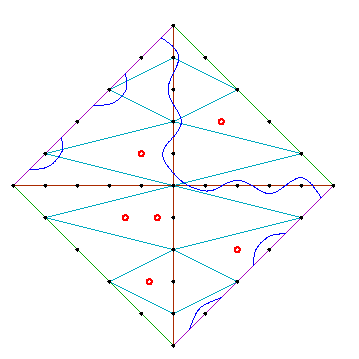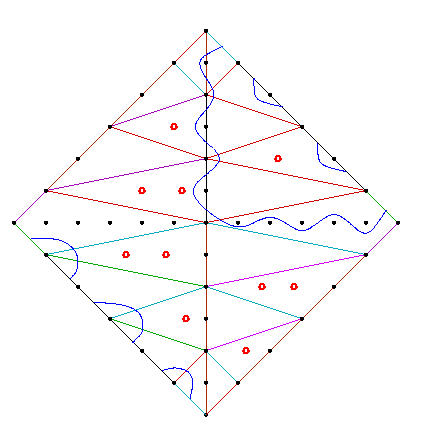


Viro's method for constructing real plane curves with prescribed topology [Vi83, Vi84] (see also [Ri]) begins with a subdivision of the simplex


 gives a
PL-space homeomorphic to
gives a
PL-space homeomorphic to  .
.
The other ingredient is, for each facet F of the subdivision, a real
polynomial fF whose Newton polytope is F and
such that fF=0 defines a
smooth curve in the torus  .
These polynomials additionally satisfy a compatibility condition:
For an edge e common to two facets F and G,
we have fF|e
=fG|e, where the latter expressions
denote the truncations of the polynomials fF and
fG to the edge e (i.e., those monomials whose
exponent vector is in e).
Furthermore, this common truncation
has no multiple factors (except x and y).
.
These polynomials additionally satisfy a compatibility condition:
For an edge e common to two facets F and G,
we have fF|e
=fG|e, where the latter expressions
denote the truncations of the polynomials fF and
fG to the edge e (i.e., those monomials whose
exponent vector is in e).
Furthermore, this common truncation
has no multiple factors (except x and y).
The real points of the real curve fF=0 lie
naturally in the four copies of the facet
F in  (with the boundary points
representing the asymptotic behavior of solutions, or, equivalently,
the zeros of the restriction fF to the corresponding edge).
The pair consisting of these facets and curves
will be called the Newton portrait
of fF=0.
By the compatibility condition, the Newton portraits of the facet curves glue
naturally together, giving a topological curve
(with the boundary points
representing the asymptotic behavior of solutions, or, equivalently,
the zeros of the restriction fF to the corresponding edge).
The pair consisting of these facets and curves
will be called the Newton portrait
of fF=0.
By the compatibility condition, the Newton portraits of the facet curves glue
naturally together, giving a topological curve  in
in
 .
Viro's theorem asserts that there exists a curve C of degree d
in
.
Viro's theorem asserts that there exists a curve C of degree d
in  such that the pair
(
such that the pair
( ,C)
is homeomorphic to the pair
(
,C)
is homeomorphic to the pair
( ,
,
 ).
The homeomorphism
preserves each coordinate axis and each quadrant.
The complex points of C are smooth, and
).
The homeomorphism
preserves each coordinate axis and each quadrant.
The complex points of C are smooth, and
 and C meet
each coordinate axis in the same number of points.
and C meet
each coordinate axis in the same number of points.
Shustin [Sh85]
(see also [Sh93,
Sh98]) showed how to modify
this construction when the facet curves (fF=0) have
singularities in  .
If a numerical criterion is satisfied
(such a criterion is given in Theorem 1.7
of [Sh93]), there exists a curve
of degree d in
.
If a numerical criterion is satisfied
(such a criterion is given in Theorem 1.7
of [Sh93]), there exists a curve
of degree d in  whose singularities are the disjoint
union of the singularities of the facet curves, and whose topology is glued
from that of the facet curves as before.
(See Theorem~1.8 of [Sh93], originally
proven in [Sh85].)
In particular, Shustin shows the following.
whose singularities are the disjoint
union of the singularities of the facet curves, and whose topology is glued
from that of the facet curves as before.
(See Theorem~1.8 of [Sh93], originally
proven in [Sh85].)
In particular, Shustin shows the following.
Proposition 7.ii.1.
(See [Sh85]
and [Sh93)
If the singularities of the facet curves are only nodal, then there exists a
curve of degree d in  whose only (complex) singularities
are the disjoint union of the singularities of the facet curves, and whose
topology is given by gluing the facet curves as in the Viro construction.
whose only (complex) singularities
are the disjoint union of the singularities of the facet curves, and whose
topology is given by gluing the facet curves as in the Viro construction.
We use this to construct maximally inflected curves of any degree whose only
ramification is flexes and whose double points are all solitary points.
Consider the subdivision of  given by the piecewise linear convex lifting function w
which we define for some the vertices of
given by the piecewise linear convex lifting function w
which we define for some the vertices of  .
Set w(0,0) = w(d,0) = 0, and
.
Set w(0,0) = w(d,0) = 0, and
|
w(0, 2i+2) = (2i+2)2 w(d-1-2i, 2i+1) = (2i+1)2 |
for i an integer between 0 and (d-1)/2 . |
 and the values of the lifting function.
and the values of the lifting function.
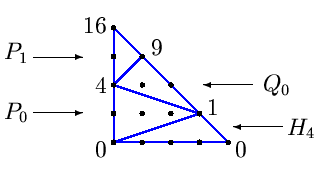
 has three
types of triangles
has three
types of triangles
| (i) | The triangle Hd with vertices {(0,0), (d,0), (d-1,1)}. |
| (ii) | The triangle Pi with vertices {(0,2i), (0,2i+2), (d-1-2i,2i+1)} for each integer i lying between 0 and (d-1)/2. |
| (iii) | The triangle Qi with vertices {(0,2i+2), (d-1-2i,2i+1), (d-3-2i,2i+3)} for each integer i lying between 0 and (d-3)/2. |
For each facet, we give polynomials fF
that define curves with only solitary points.
These will not necessarily satisfy the compatibility
condition, but rather a weaker one:
A common edge e between two facets F and G contains only
two lattice points, and after possibly multiplying one of the facet
polynomials by -1, the signs of the monomials from the two facet polynomials
agree.
This weak compatibility implies that there are monomial transformations
with positive coefficients of the
facet polynomials which do satisfy the compatibility criteria
after adjusting the sign of one of the two polynomials.
Since these monomial transformations do not change the geometry
(number of solitary points, topology of the glued curve
 ),
and the dual graph to the triangulation is a chain,
it will suffice to construct polynomials satisfying the weaker criteria
and giving the desired topology.
We describe the monomial transformations.
Consider first a common edge e between adjacent facets F and
G of the triangulation.
Since e has no interior lattice points, the restrictions of the facet
polynomials to e will be binomials of the form
),
and the dual graph to the triangulation is a chain,
it will suffice to construct polynomials satisfying the weaker criteria
and giving the desired topology.
We describe the monomial transformations.
Consider first a common edge e between adjacent facets F and
G of the triangulation.
Since e has no interior lattice points, the restrictions of the facet
polynomials to e will be binomials of the form



Since the dual graph of the triangulation is a chain, we encounter no obstructions when transforming the facet polynomials so that they satisfy the compatibility condition. More precisely, given the facet polynomial for Hd, we transform the facet polynomial for P0 as above, then the facet polynomial for Q0, then for P1, and et cetera.
We now give the facet polynomials. The reader is invited to check that the weak compatibility conditions are satisfied. The facet Hd is the Newton polytope of the polynomial hd := xd-1y - (1-x)(2-x) ... (d-x). Here are the Newton portraits of h3 and h4.
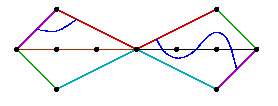

The remaining facet polynomials are based on an idea of
Shustin [p. 849, Sh93].
Recall that the Chebyshev polynomials
 k(x)
(defined recursively by
k(x)
(defined recursively by
 0 := 1,
0 := 1,
 1 := x,
and for k>1,
1 := x,
and for k>1,
 k(x) :=
2x
k(x) :=
2x k-1(x)
-
k-1(x)
-  k-2(x) .)
k-2(x) .)
 k-1(x)
has exactly k roots in the interval (-1,1) and
k-1 local extrema in this interval with values at 1 and -1, and
for |x|>1, |
k-1(x)
has exactly k roots in the interval (-1,1) and
k-1 local extrema in this interval with values at 1 and -1, and
for |x|>1, | k(x)|>1.
Lastly, the leading term of <
k(x)|>1.
Lastly, the leading term of < k(x)
is 2k-1xk.
Then the polynomial
fk(x):=y2-
2y
k(x)
is 2k-1xk.
Then the polynomial
fk(x):=y2-
2y k(x+2)+1 has Newton
polytope the triangle
k(x+2)+1 has Newton
polytope the triangle
 has 2 connected
components and k-1 solitary points.
We display these curves for k=2, 3, and 4, scaling the y-axis by
the transformation y |----> sgn(y)|y|1/k.
has 2 connected
components and k-1 solitary points.
We display these curves for k=2, 3, and 4, scaling the y-axis by
the transformation y |----> sgn(y)|y|1/k.

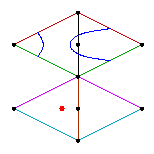
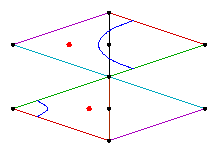
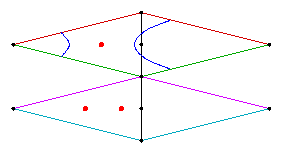
Finally, set



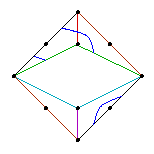
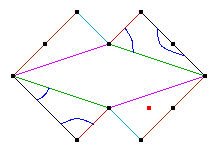
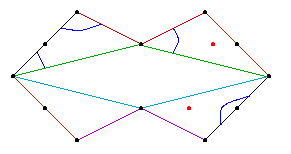
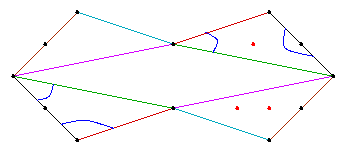
The curve Cd constructed from these data by
Proposition 7.ii.1
has 3(d-2) flexes and
 solitary points as claimed.
First, since the facet curves fk and gk
each have k-1 solitary points,
Cd has
(d-2)+(d-3)+\cdots+1+0 =
solitary points as claimed.
First, since the facet curves fk and gk
each have k-1 solitary points,
Cd has
(d-2)+(d-3)+\cdots+1+0 =  solitary points, and so is rational (in fact, the solitary points
correspond to internal integer points of the Newton polygon).
From the Newton portrait
of hd, we see that Cd meets the
x-axis in d points.
Each facet Pk contributes 2 points of intersection of
Cd with
the y-axis.
When d is even, this gives d points of intersection, and when
d is odd, d-1 points of intersection.
When d is odd, the last facet Q1
(corresponding to g1)
contributes an additional point of
intersection with the y-axis.
Finally, each facet Qk contributes 2 points of intersection
of Cd with the
z-axis, giving d-2 points of intersection when d is even
and d-1 points
of intersection when d is odd.
The facet Hd contributes an additional point, and when
d is even, the facet
solitary points, and so is rational (in fact, the solitary points
correspond to internal integer points of the Newton polygon).
From the Newton portrait
of hd, we see that Cd meets the
x-axis in d points.
Each facet Pk contributes 2 points of intersection of
Cd with
the y-axis.
When d is even, this gives d points of intersection, and when
d is odd, d-1 points of intersection.
When d is odd, the last facet Q1
(corresponding to g1)
contributes an additional point of
intersection with the y-axis.
Finally, each facet Qk contributes 2 points of intersection
of Cd with the
z-axis, giving d-2 points of intersection when d is even
and d-1 points
of intersection when d is odd.
The facet Hd contributes an additional point, and when
d is even, the facet  (corresponding to f2)
contributes one point.
(corresponding to f2)
contributes one point.
As a result, the curve Cd
has three separate segments, each intersecting
a different coordinate axis in d consecutive points going in the same
order on the curve and on the axis.
Thus, by counting the Whitney indices by means of the
Gauss map we find at least d-2 flexes on each segment.
Hence, the curve constructed has 3(d-2) flexes.

We show the curves C4, C5, and C6. The curves next to C4 and C5 are curves we computed that have the same topological type as the patchworked curves.
